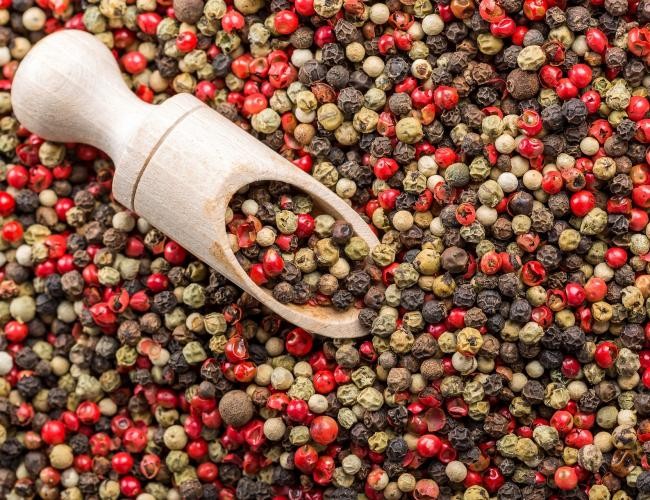Pepper price on November 7 suddenly reversed and skyrocketed by 1,000 VND/kg because the market showed signs of optimistic information about China increasing pepper imports to meet year-end consumption demand.
Pepper price 7/11: Pepper price reversed to increase by 1,000 VND/kg
Pepper prices 7/11 suddenly increased in key growing areas. Specifically, in Gia Lai, today’s pepper price was purchased by traders at 56,500 VND/kg, an increase of 500 VND/kg. In Dak Lak, Dak Nong, pepper prices 7/11 remained at 58,000 VND/kg, up 1,000 VND/kg.
Similarly, in the Southeast region, pepper prices also increased. In Dong Nai and Binh Phuoc, pepper price were at 59,000 VND/kg, up 1,000 VND/kg. In Vung Tau, the latest pepper prices today fluctuated around 60,000 VND/kg, up 1,000 VND/kg.
On the world market, the price of Lampung black pepper was stable at 3,645 USD/ton; Brazilian black pepper ASTA 570 is $2,575/ton. Indonesia’s Muntok white pepper price is at $5,899/ton. Meanwhile, pepper prices remained stable in the remaining countries. Specifically, Brazilian black pepper ASTA 570: at $2,600/ton, unchanged. Kuching black pepper (Malaysia) ASTA: at $5,100/ton, unchanged. Malaysian white pepper ASTA: at $7,300/ton, unchanged.

In Vietnam, the price of black pepper is 3,250 – 3,350 USD/ton for 500 g/l and 550g/l; white pepper prices 4,850 USD/ton.
Thus, after a series of 7 days of silence without reaction, the domestic pepper price suddenly increased from 500-1,000 VND/kg in localities. Summarizing last week, pepper price increased by 500 – 1,000 VND/kg while last week, pepper prices decreased by 500 – 1,000 VND/kg.
The Vietnam Pepper Association (VPA) said that the market had mixed reactions last week, only the export price of Vietnamese pepper recorded an increase.
Accordingly, after 2 weeks of stability, Indian pepper prices decreased while Sri Lankan domestic pepper prices continued to be stable. In Southeast Asia, Indonesian pepper prices also fell as the Indonesian Rupiah fell 1% against the USD (15,662 IDR/USD) amid less interest in growing pepper due to higher production costs and the impact of the epidemic. . Malaysian domestic pepper prices also continued to decline. Meanwhile, Malaysian pepper prices traded on the international market continued to be stable and unchanged.
Only the price of Vietnamese pepper traded on the international market increased by 100 USD/ton. Meanwhile, the other types are stable and unchanged.
Pepper prices increased because the market appeared positive information about China’s increase in pepper imports to meet year-end consumption demand. At the moment, Vietnam’s pepper price depends on the Chinese market when European and US importers have signed contracts until the end of this year.
Chinese traders and large exporters in Vietnam are in a waiting state, while farmers and small dealers tend to hold their goods in anticipation of higher prices.
According to data from China Customs, the country’s pepper import turnover in August 2022 reached US$2.65 million, down 34.6% compared to August 2021. Generally, in the first eight months of 2022, China’s pepper import turnover reached approximately US$30.12 million, down 20.1% over the same period in 2021.
Supply structure in the first 8 months of 2022, China imported pepper from 22 countries and territories around the world. In particular, China imports pepper mainly from markets such as Indonesia, Vietnam, Brazil, Italy, Malaysia, and India.
In August 2022, Vietnam became the largest pepper supplier to China, with a turnover of approximately 1.15 million USD, down 31.9% compared to August 2021. Generally in the first 8 months of 2022, China’s pepper imports from Vietnam reached US$9.47 million, down 10.7% over the same period in 2021. Vietnam’s pepper market share in the total import turnover of Vietnam China increased from 28.15% in the first 8 months of 2021 to 31.46% in the first 8 months of 2022.
In August 2022, Indonesia became the second largest pepper supplier to China, with a turnover of US$895,000, down 48.1% compared to August 2021. In general, in the first 8 months of 2022, Indonesia is still the largest pepper supplier to China, with a turnover of approximately 14.64 million USD, down 25.7% compared to the same period in 2021. Indonesia’s pepper market share of China’s total imports decreased from 52.32% in the first eight months of 2021 to 48.6% in the first eight months of 2022.


 中文 (中国)
中文 (中国)